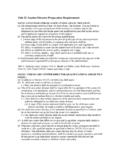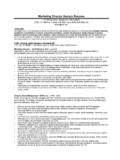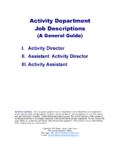Transcription of Director and Executive Officer Roles in a Nonprofit …
1 Clay M. GraysonGrayson Thomas, 5888 Director and Executive Officer Roles in a Nonprofit and Tax exempt OrganizationsBehavioral Health Services Association of SCJanuary 27, 2018 Nonprofit Leadership No man will make a great leader who wants to do it all himself or get all the credit for doing it. Andrew CarnegieNonprofit Boards and their CEOsTHEFUNDAMENTALRELATIONSHIP Foundation Lynchpin SpearTip Strategy meetsoperationsNonprofit Leadership Division of Responsibilities Board Strategic vision Budget Policy Oversight CEO Executes vision Day to day operations Management of Programs Manages employeesNonprofit LeadershipRelationshipDynamics: Fiduciaries Employer/employee Contract Statute/PublicPolicyNonprofit Leadership FiduciariesBoard Fiduciary Obligations For SC Nonprofit Corporations, except under certain circumstances, all corporate powers must be exercised by or under the authority of and the affairs of the corporation managed under the direction of its board.
2 SC Code section33 31 801(b). For organizations created by statute or legislation, authority conveyed directly from state board; scope of authority provided by Duties Code Ann. 33 31 830(a) sets forth the general standards of conduct for directors of nonprofits, and requires directors to act: 1) in good faith; 2) with the care an ordinarily prudent person in a like position would exercise under similar circumstances; and 3) in a manner the Director reasonably believes to be in the best interest of the corporationNonprofit Leadership FiduciariesDirector Duties Code Ann. 33 31 831(a), Conflicts of Interest: A conflict of interest transaction is a transaction with the corporation in which a Director of the corporation has a direct or indirect interest. SCEthicsAct Section8 13 700 May not use office to obtain economic gain for himself, familymember,orbusinesscolleague. IRSC onflictofInterestPolicy: Duties Associated with Tax Exemption Internal Revenue Code (IRC) Section 501(c)(3) really provides a description of what is a tax exempt organization : Corporations, and any community chest, fund, or foundation, organized and operated exclusively for religious, charitable, scientific, testing for public safety, literary, or educational purposes, or to foster national or international amateur sports competition.
3 Or for the prevention of cruelty to children or Charitable Purpose is the leading Against Private Inurement IRC Section 501(c)(3) additionally provides:no part of the net earnings of which inures to the benefit of any private shareholder or individual Must put organization before self. Observe conflict of interest policy and rules at all and other Officers Federal duties apply to all officers. Code Ann. 33 31 842 sets forth the general standards of conduct for officers with discretionaryauthority Held accountable at same Fiduciary standard as the Board. Critical to understand and documentthe grant and scope of discretionary authority provided to Sources of Authority Under state law, the Board causes authority to be granted to CEO. See Code Ann. 33 31 841 Scope of such Authority is defined within: Bylaws Expenditure Controls Policies Employee HandbookTraditional Role of CEO The CEO/ Executive Director runs the day to day management activities of the Nonprofit , which can include: Reports to the Board of Directors Manages employees Implements Policies and Programs of Nonprofit and directives of Board.
4 Maintenance of the boundary between Board and CEO is critical for the health of a NonprofitEmployment Arrangement Board as Employer CEO as Employee Professional Employer Organizations Employment Agreement Defines duties and role of CEO Defines termination and severanceCEO Compensation Compensation discussion illustrates a potential conflict between a Board and its CEO Implicates private inurement both at the time of the hiring and perhaps more influentially at contract renewal points or during future compensation negotiation. CEO as an influential insider of the Director Compensation CEO compensation must notexceed what is fair andreasonable. The IRS strictly enforces andprohibits privateinurement. Excessive compensation paid to Nonprofit executives is the most common violation of this prohibition. IRS penaltiesfor excess compensation range from fines to revocation of the organization s tax exempt CompensationExcess Benefit Transactions Introduced in 1996pursuant to IRC 4958 as a form of Intermediate Sanctions.
5 An excess benefit transaction is a common type of private inurement, and occurs when an insider, technically referred to as a disqualified person receives an unreasonable benefit pursuant to a transaction with the organization . This is the 501(c)(3) equivalent of insider CompensationExcess Benefit Transactions A disqualified person includes: any person who was, at any time during the 5 year period ending on the date of such transaction, in a position to exercise substantial influence over the affairs of the organization a member of the family of an individual described above a 35 percent controlled entity A disqualified person is also anyone that has substantial influence over the Nonprofit , like a Director or Officer , including the CompensationExcess Benefit Transactions Intermediate Sanctions take the form of Excise Taxes: First Tier Tax: a 25% tax on the excess benefit payable by the disqualified person Second Tier Tax.
6 If not paid, an additional tax of 200% of the excess benefit is imposed on the disqualified person A tax of 10% is ALSO imposed on the organization managers ( Board members, officers) who knowingly approved the transactionCEO CompensationExcess Benefit Transactions Standard of Reasonableness Compensation is reasonable if the value of services equals the amount that would be paid ordinarily for like services by like enterprises, whether taxable or tax exempt , under like circumstances. Treas. Reg 4(b)(1)(ii)(A). Based on all the relevant facts and circumstances. Treas. Reg. 4(b)CEO CompensationExcess Benefit Transactions Rebuttable Presumption of Reasonableness Requirements: Recusal of persons with Conflict of Interest Board must rely on appropriate comparability data prior to making significant decisions; and Properly document each decision at the time made and include the basis for the decision. Example: Private Letter Ruling 200244028 Must meet all three requirements to establish the rebuttable presumption of reasonableness.
7 Here there was no consideration of comparability data, therefore the organization did not establish the rebuttable Decisions A current Director wants to be What problems does this present? The Board wants to hire her what should we do? Resignation Manage disqualified person status will remain Rebuttable presumption of reasonablenessCEO Performance EvaluationCEO Performance Evaluation Board should ensure CEO: Understands the role of CEO in relation to the statedobjectives of the Board Is educated about how to work with and communicatewith the Board Understands how he or she will be held accountable and evaluatedCEO Performance Evaluation Annual Performance Metrics establish at beginning of the year. Agree upon measures and a defined process to evaluate CEO Accept input from CEOfor performance metrics, but understand limitations and Performance Evaluation Who will evaluate CEO make this known to CEO early in year; Self evaluation by CEO at conclusion of year; Presentation of report to CEO; Provide corrective guidance upon finding of deficiency Board and CEO signs off on the Board CEO RelationshipExamining the Board CEO Relationship Relationship between CEO and Chair.
8 Collaboration, trust, respect, mutual support. Communicate Lunch or coffee between CEO and individual directors goes a long way. Board meetings are a critical a moment to evaluate leadership, organization , and operations. Chair and CEO to develop TOP 10 SIGNS OF A DYSFUNCTIONAL CEO / BOARD CHAIR RELATIONSHIP Joan Garry(1) Board Chair didn t want the job in the first place. Was the only person who didn t step back when the ask was made.(2) CEO doesn t tell the Board Chair anything meaningful. Keeps her at arm s length. Hopes they don t interact a lot. Perceives interaction as intrusion. (3) Board Chair intrudes. Sees the role as good old standard boss/employee relationship and attempts to micro manage the activities of the CEO.(4) Board Chair actually wants the CEO job.(5)Board Chair comes in distrusting / disrespecting the CEO and uses the platform to make the case that it is time to boot him.(6)CEO believes that the Board Chair s primarily role is to protect her from the big bad Board.
9 (7) Board Chair sees her role as providing cover for CEO and to save her from the annoying board with their nutty ideas.(8) Board Chair is not accessible to the CEO when she needs him.(9) There is no regular communication in either direction.(10) Board chair delegates board and Executive committee meeting agendas and actual running of the meeting to the CEON urturing the Bond between a Board and its CEO Encourage Board involvement as volunteer or fundraiser. Guard against Director overstepping line into CEO role. Empower CEO as sole manager of the employees he or she hires. Employees that run around CEO to Board Engage staff to support appropriately the Board and its committeesNurturing the Bond between a Board and its CEO Strategic Planning and Regular Budgeting. Engage CEO as a critical voice in any such discussions. Search and nomination of new directors CEO will have an opinion on needs of Nonprofit Board sees the professional development of CEO as investment in the the Bond between a Board and its CEO Communication is key Document scope of authority of CEO.
10 Performance reviews and constructive feedback. Make regular times for CEO and Chair to meet Despite conflict, take a breath and remember the mission! Nonprofit Leadership There are many leaders, not just one. Leadership is distributed. It resides not solely in the individual at the top, but in every person at every level who, in one way or another, acts as a leader to a group of followers wherever in the organization that person is, whether shop steward, team head, or CEO. Daniel Goleman, Richard Boyatzisand Annie McKeePrimal Leadership: Realizing the Power of Emotional Intelligence. THANK YOU!Clay M. GraysonGrayson Thomas, 5888





